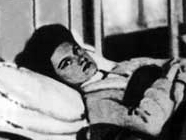I wrote about public health a couple of weeks ago: specifically how I became fascinated by the people who do the detective work of tracking infections and threats to the public weal to their sources. In doing so I was reminded of Typhoid Mary Mallon. She was an interesting and rather tragic character. And stubborn as hell.

Mary Mallon emigrated to the US from County Tyrone, Ireland, when she was 15 years old. She stayed with family for a while, but for most of her professional life she “lived in” as a domestic worker, almost always as a cook. And she was an asymptomatic carrier of typhoid, which is not a quality you want in someone involved in food prep. It is possible that she was infected in utero: that her mother had typhoid when she was pregnant. But Mary was, initially at least, unaware. And cooking was what she knew.
In 1900 Mary started working in Mamaroneck, a suburb of New York City. Within a couple of weeks people there fell ill. She left that job and went to the city. At her first post there several people became ill with fevers and diarrhea; she moved to another job soon after, and seven of the eight people in this new household became sick. In 1904 she went to work for the Gilsey family, where, once again, people became ill (no one in the family itself–Mary was cooking for the house staff). Once again Mary decamped, and got a job in Tuxedo Park, NY (yes, where the tuxedo was created). Within two weeks a member of the household staff came down with typhoid and was hospitalized. This time the staff member died, and again, Mary departed ahead of inquiry. Eventually, Mary wound up in toney Oyster Bay, Long Island, working for banker Charles Warren in a rented summer cottage. When more than half the people in the family came down with typhoid, the property’s owner became involved. Aside from the awfulness of the illness itself, the outbreak brought down the property value: typhoid was considered, at the time, to be a disease that only poor people in squalid circumstances got. Worrying that potential renters would believe he had a “sick” house, the owner had the pipes tested, looking for the possibility that the property itself was the culprit. The pipe and house came up clean. They had to look elsewhere.
So the owner of that Oyster Bay property hired an investigator, George Soper, to figure out how disease had come to his house in Oyster Bay. Backtracking, Soper could find only one person, an Irish cook who fitted a specific physical description, who had been at the site of all the outbreaks; Mary changed her name from job to job, but her accent and her description made her fairly easy to trace. Eventually Soper tracked her to the city, working for a family on Park Avenue.
Their meeting did not go well.
We forget, these days, that when Mary Mallon was told that she was a carrier, many people didn’t believe in germ theory. The idea that there were little thingies in your body which could not only cause disease but could somehow leap to other people’s bodies and make them sick, was fantastic. Mary Mallon certainly didn’t believe it: she threatened Soper with a carving fork. She refused to give urine or stool samples. Without Mary’s cooperation Soper had to establish an airtight history, and he did it. Over five years, members of seven out of the eight families Mary Mallon had worked for had contracted typhoid. Mary, her livelihood imperiled, denied any possible involvement: typhoid was everywhere, the food must have been contaminated by someone else, this was a plot to implicate her, a poor, innocent domestic worker… and Irish to boot. (Anti-Irish prejudice was still a thing at the beginning of the 20th century.)
Having no luck trying to deal with Mary Mallon, Soper went to the department of Public Health. They went all in and arrested her: she was forced into an ambulance by five policeman and a female doctor (who had to sit on her). At the hospital she was forced to give samples. They were found to be teeming with typhoid bacteria.
Public Health was a new thing in 1907, and I don’t think there had ever been a case like Mary Mallon’s before to establish precedent. Mallon made it clear she didn’t believe she was a carrier and would not cooperate; when doctors decided that the likeliest reservoir of bacteria in her system was her gallbladder, and suggested having it removed could solve the problem, Mallon refused.* The DPH and the legal system was convinced she posed a danger to the community, and she was sentenced to quarantine on an island in the East River. There she lived, giving stool and urine samples three times a week (perhaps someone thought she might magically test negative some day? In any event, it did not happen). Mallon could not do the work she did best (apparently she was a very good cook) and was living on the verge of poverty when George Soper visited and suggested that he would write a book about her case and give her half the proceeds. Rather than seeing this as a unique business opportunity, Mary locked herself in the bathroom until he left: understandably she detested being called Typhoid Mary.
In 1910 Mary was released from quarantine on the condition that she never work again as a cook, and that she take pains to avoid communication of disease to others (it is reported that Mary Mallon didn’t see much point in washing her hands until she thought they were dirty… and they didn’t look dirty after she used the toilet, so why wash then?). Quarantine had been hard on her: she was used as a guinea pig with trials of various medications, and non-typhoid illness was ignored. I suspect she would have promised anything to get off the island and back to something like a normal life. Once back in the city Mary found work as a laundress, but it paid only half of what she could make as a cook, and she didn’t like the work. After a year or so she started cooking again, using assumed names. Staffing agencies wouldn’t hire her, so she went directly to the kitchens of hotels and restaurants, and predictably, sadly, everywhere she worked there were typhoid outbreaks.
In 1915 Mallon went to work in the kitchen of the Sloane Hospital for Women. Patients got sick. Two died. George Soper, Ace Typhoid Investigator, identified Mary Mallon. She was again arrested, and again sentenced to quarantine on North Brother Island, where she stayed for the next 23 years. She was given a cottage to live in, and wound up working in a laboratory on the island as a technician.
Public opinion, which had initially seen Mary Mallon as a villain–not just disease, but that carving fork! the swearing and fighting back!–later reversed, and there was some sympathy for a woman who, through no fault of her own, found herself a public danger and unable to do the one thing she was demonstrably good at. Mary Mallon had a stroke in 1932 and died in 1938 at the age of 69. The nickname she hated is still in use, associated with recklessness, callousness, and the spreading of disease. Poor Mary.
__________
*gallbladder surgery was not the commonplace is is now. Mallon could legitimately have feared that she would die on the table.
